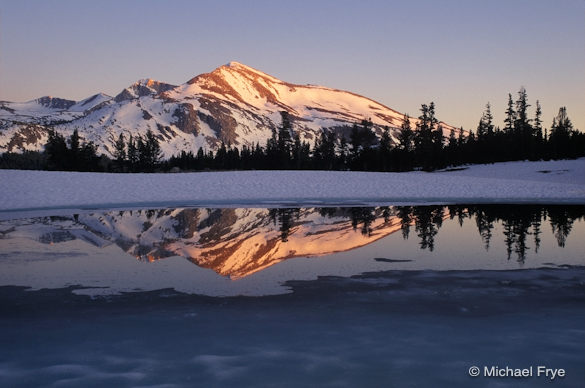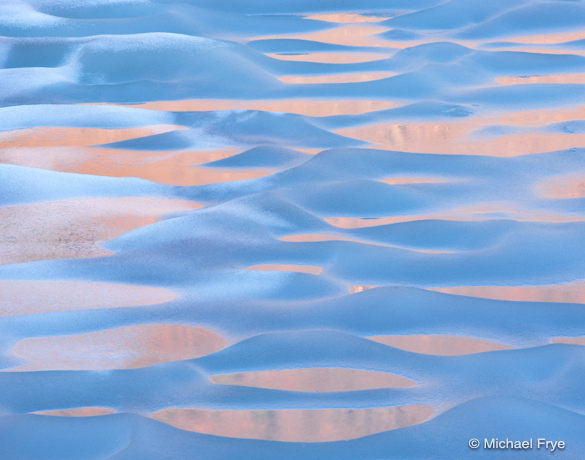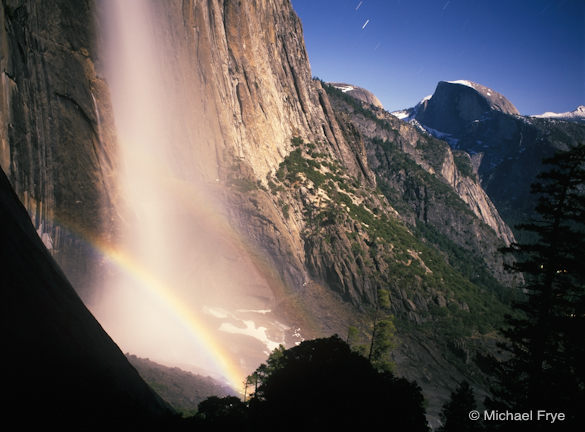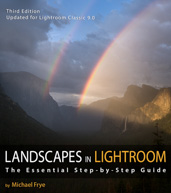by Michael Frye | Oct 6, 2010 | Yosemite Photo Conditions
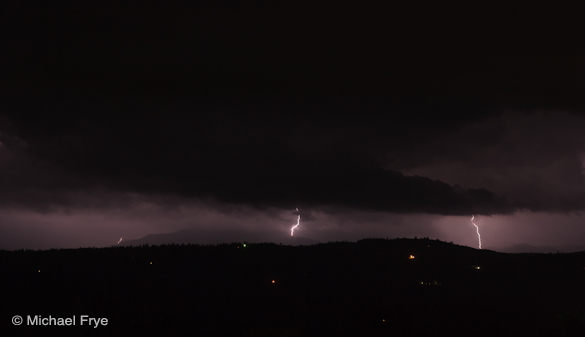
Lightning striking the Sierra foothills near Mariposa on Sunday night
October literally started with a bang, as thunderclaps rang through Yosemite Valley. It poured Saturday afternoon. Near Pohono Bridge the Merced River was brown, filled with silt, something I’ve seen only a few times in the last 27 years.
At about 11 o’clock Sunday night my wife and I got in our outdoor hot tub—a nightly ritual—and immediately noticed flashes behind the ridge to our west. We couldn’t hear anything, but knew it must be distant lightning. The frequency was impressive, a nearly constant flickering.
Even though we planned to head over Tioga Pass to Bishop the next morning, and needed to get up early, we decided to go out and take a look. We drove to a spot on Triangle Road, less than half a mile from our house in Mariposa, with a panoramic view to the south. From there we could see that flickering behind a ridge to the west, but also an even more intense thunderstorm to the south, near Fresno. This second cell put on a great light show, with nearly continuous flashes. It gradually moved closer, then slid by to the east, so we were able to watch it for over two hours.
Of course I tried to photograph the lightning, but unfortunately we saw few bolts hit the ground. Most of the show consisted of cloud-to-cloud lightning, and the streaks were usually hidden within the clouds. But I managed to capture a few good images, including the one at the top of this post.
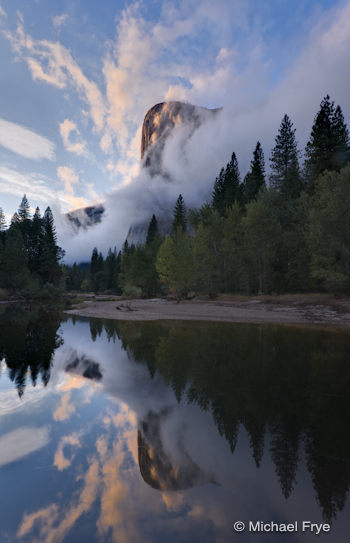
El Capitan at sunset, Tuesday evening
By the next morning rain had changed to snow at the higher elevations of the Sierra, and Tioga Pass was closed. We started driving north to Sonora Pass, but then learned that had closed too. Reluctantly we turned around rather than face a six or seven hour drive to Bishop.
I had to console myself by photographing a beautiful, seldom-visited location: Yosemite Valley. After receiving almost two inches of rain since Friday, skies cleared over the valley Tuesday, and I was able to photograph El Capitan at sunset surrounded by mist and clouds.
Since I never made it to the other side of the mountains, I can’t tell you first hand about the fall color over there, but Evan Russell, an Ansel Adams Gallery staff photographer and one of my workshop assistants, told me that the color is great west of Bishop around North Lake, South Lake, and Lake Sabrina. Or at least it was Monday. Tuesday it snowed up there, and many aspens lost their leaves. Typically a storm will strip most of the trees that are already turning, so it may be another week or two until the trees that are now green will change and provide another dose of fall color.
News like this—that some of the early season aspen spots may lose their leaves—often elicits anxious comments in forums, with people worried that they may have missed fall, and others adding fuel to the angst by saying that if you don’t go right now, or better still, yesterday, you’ll miss the most fantastic, wondrous, amazing fall color ever!
Let me assure you that fall isn’t over in the Sierra. Most of the aspens in classic eastern Sierra spots like McGee Creek, June Lake Loop, Lee Vining Canyon, and Lundy Canyon are still green, and probably weren’t adversely affected by the recent storms. While there are no guarantees—there are many little-understood factors that affect fall foliage—chances are good that these areas will produce wonderful color later in the month. I’ve made many of my best aspen photographs during the third week of October. Here’s one example.
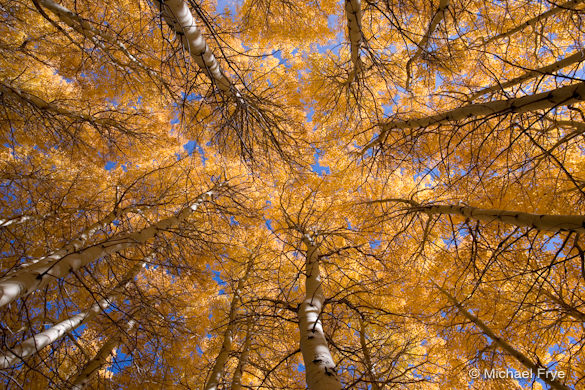
Aspen Grove, June Lake Loop, October 23rd, 2006
And if the aspens don’t produce more great color this year, there are always maples, dogwoods, oaks, and cottonwoods in Yosemite Valley. Peak fall foliage in the valley doesn’t usually occur until the end of October or beginning of November, but the rain and cold temperatures have set things in motion, and many maples and dogwoods have already started to change color. It looks like autumn might arrive early in the valley this year, but these things are always hard to predict.
I’m hoping to try again to get over to the east side later this week, so I’ll let you know what I find. In the mean time, a good resource for fall color reports is the Calphoto web site. Also, if you’ve been photographing aspens recently, or captured some of the storm activity in Yosemite, please use the comments to tell us what you found, and post links to photos!
by Michael Frye | Jun 12, 2010 | Yosemite Photo Conditions
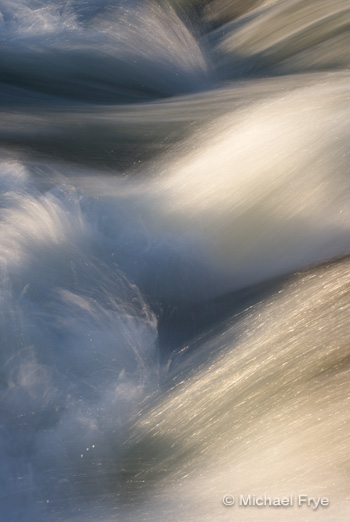 While the snow at high elevations in Yosemite is melting rapidly, there’s still plenty around,enough to keep the water flow high as it melts. While the snow at high elevations in forecast calls for warmer temperatures Sunday and Monday, so the water volume in Yosemite Valley should increase—maybe not to the level we saw last weekend, but close. After that, temperatures are supposed to cool down again, so that may be the end of the highest water this year, as most of the snow will be gone soon.
While the snow at high elevations in Yosemite is melting rapidly, there’s still plenty around,enough to keep the water flow high as it melts. While the snow at high elevations in forecast calls for warmer temperatures Sunday and Monday, so the water volume in Yosemite Valley should increase—maybe not to the level we saw last weekend, but close. After that, temperatures are supposed to cool down again, so that may be the end of the highest water this year, as most of the snow will be gone soon.
by Michael Frye | Jun 4, 2010 | Yosemite Photo Conditions
Mammoth Peak from near Tioga Pass
Tioga Pass is scheduled to open tomorrow morning at 8 a.m. When it does, there should be lots of snow at higher elevations, creating some great opportunities to photograph snowy peaks and icy lakes.
The Glacier Point Road opened last Saturday, providing access to some of Yosemite’s best views, and the some of the prettiest meadows in Yosemite, like Summit, McGurk, and Westfall. These meadows should be sprouting corn lilies, which I wrote about on my other blog.
The National Weather Service has issued a flood watch for Yosemite Valley. They’re expecting the Merced River to crest above flood stage on Sunday and Monday mornings, and possibly Tuesday as well. This minor flooding shouldn’t impact travel, but means that the waterfalls will be roaring, and meadows will be partially flooded, creating nice reflecting ponds everywhere.
You can still find dogwoods blooming in Yosemite Valley, although they’re rather ragged. Although I haven’t had a chance to check them, the dogwoods at higher elevations should still be in good shape. My favorite place to photograph dogwoods outside the valley is in the Tuolumne Grove, where you can find them blooming next to giant sequoias.
Speaking of the high country, a space has opened up in my Hidden Yosemite workshop in July. This has always been a really fun class, featuring short hikes to some of the best locations near Tenaya Lake, Tioga Pass, Tuolumne Meadows. Click here for more information.
Melting Ice near Middle Gaylor Lake
by Michael Frye | Apr 25, 2010 | Advanced Techniques, Photography Tips
Half Dome and Upper Yosemite Fall with a lunar rainbow
In Friday’s post on my other blog I described some of my experiences attempting to photograph lunar rainbows, but here are some tips for capturing your own moonbow images.
The moon will become full at 5:19 Wednesday morning, so Tuesday night will provide the brightest moonlight, and the best chance to photograph a lunar rainbow this month—if the weather cooperates. Unfortunately the forecast calls for rain. If the predictions are faulty, and some moonlight manages to break through the clouds, cool temperatures will probably limit the amount of spray on Upper Yosemite Fall, so Lower Yosemite Fall may work better. For the upper fall, you might be better off waiting for the next full moon on May 27th. For detailed information on times and places to photograph lunar rainbows in Yosemite, see Don Olson’s site.
For those who aspire to capture lunar rainbows, here are some tips.
Equipment
Any digital SLR will work, but full-frame sensors usually produce less noise and work better for the long exposures required at night. A sturdy tripod is essential, plus a locking cable release or electronic release. You’ll want a good flashlight or headlamp, a watch to time long exposures, and a cloth for wiping spray off the lens if you’re at the lower fall. Long exposures drain batteries quickly, so make sure your camera battery is fully charged—and your spare too.
Focus and Depth of Field
To make exposure times reasonably short, you’ll have to keep your aperture wide open, or close to it. That means you won’t get much depth of field, so try to exclude foregrounds from your compositions. This shallow depth of field makes focusing critical. It’s obviously difficult to focus manually in the dark, and autofocus won’t work either. In the past I’d just manually set the lens at infinity, but many lenses now focus past infinity, making the correct focusing point difficult to determine. The solution is to find something distant that’s bright enough to focus on, like the moon itself, car headlights, or perhaps a bright light that you place far away. Then focus on that bright spot, using either manual or autofocus. The most precise method is probably focusing manually during a zoomed-in look in live view. Once you’ve set the focus, turn autofocus off and don’t touch the focusing ring—leave the lens set at this distance for all your images. You might even tape the focusing ring so it doesn’t move. (more…)
by Michael Frye | Apr 16, 2010 | Yosemite Photo Conditions
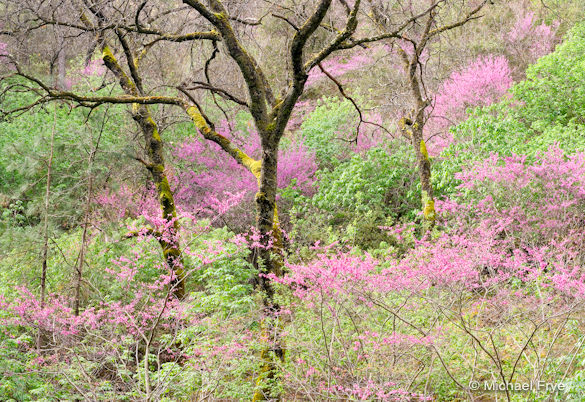
Redbud and oaks, spring 2007
The redbud in the Merced River Canyon are a bit past peak, with many starting to leaf out, but at least half are still in prime condition, so good photographs of them can still be made for at least the next few days. Meanwhile in Yosemite Valley the deciduous trees have buds but no new leaves. The April snowstorms have delayed the appearance of the vivid green leaves of the cottonwoods, alders, maples, and oaks. I expect we might see that green around the end of the month. The dogwoods will probably also be late; while they typically start blooming around the end of April, they might blossom a week or two later this year.





